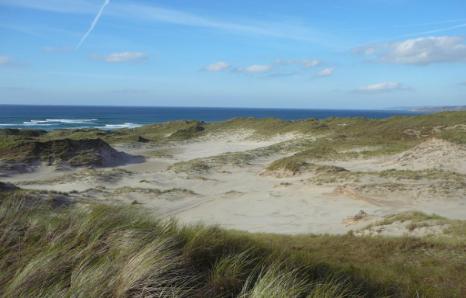
Dunes at Gweebarra Bay
Sandy shorelines are constantly on the move. In the space of just a few years, the “lie of the land” along the coast can be completely changed. The huge bare dune on the Dooey Peninsula, just north of Gortahork, which was such a landmark on Ballyness Bay, has lost most of its height in the last twenty years. And at Tramore Beach near Rosbeg the opposite situation is happening, with lines of new dunes being built up at a remarkable rate. Sand can come and go, but its overall supply is limited. It was created by glaciers grinding on rock during the last Ice Age, and we won’t get a fresh supply until an ice age comes around again.
Creating new land from sand is the job of the shoreline plants. These start to trap and hold the blowing sand, forming a front line of defence against the tide. Any plant that can thrive in this windswept and salty environment needs to be tough, and these seaside specialists have developed a whole range to tricks and tactics to help them survive. Long taproots to reach deep for fresh water; leaves designed to channel rainwater; thick fleshy ones to store water inside; silvery foliage to reflect sunlight, helping to prevent them being dried out.
Two of the most common are Sea Rocket, with clusters of small bright flowers in lilac, purple or white, and Sea Sandwort, which has tiny white flowers and leaves arranged in a very distinctive angular pattern. The next line of defence is often formed by blue-green Sand Couch-grass, and behind that, taller Marram Grass takes over – the real sand-dune builder. As the sand piles up around its stems, it sends out a new layer of roots just under the surface, adding networks at ever higher levels which can extend upwards for over twenty metres.
Machair, meaning a plain, is the name given by botanists to the flower-rich areas which stretch out on the landward side of many dune systems, fed by wind-blown sand and traditionally managed by light grazing. It’s a habitat which is actually very rare in Europe – found only in Donegal, Mayo and Galway, and some parts of north-west Scotland. Some fine examples in Donegal are at Gweedore and the Rosses, and in the Rosbeg area. It’s very sad that many of the best areas have been lost or damaged in recent years by all sorts of development, including golf courses and changes in farming activity.
At this time of year the Machair is in full bloom. In these windswept conditions most of the flowers can never raise their heads too far above the ground, so you have to get in close to admire them. Many of them come in various shades of yellow – shining Bulbous Buttercup, dusky Lady’s Bedstraw, lemony Mouse-eared Hawkweed, sheets of Birds-foot-trefoil and Kidney Vetch. This is an excellent habitat for wild orchids, with up to a dozen species often found on a good site. These lovely frilly flowers shine out in a brilliant range of purples and pinks, deep magenta and pure white, and they always highlight some of our best wild places. As with all wild flowers, the golden rule is: Never pick them!
Machair grassland is also a great place for all sorts of insect life, including a good variety of butterflies and day-flying moths. It’s the stronghold for some of our most scarce and specialised butterflies – such as Marsh Fritillary, Dingy Skipper and Small Blue, and at this time of year you can often find good numbers of Common Blues and fast-flying Dark Green Fritillaries.
The classic summer soundtrack on the coastal grasslands is the song of the Skylark. This modest little brown bird usually passes unnoticed on the ground, but it has always been famous for its spectacular flight-and-song display from high above. You usually become aware of the steady stream of loud clear twittering notes, well before you manage to locate the bird. He begins by flying up steeply, always into the wind, and then moves up vertically with wing-beats increasing to twelve per second. He stops to hover in one spot now and again for a few seconds, and can rise to as high as a hundred metres. The length and volume of the song is a measure of the strength of the bird, designed to impress his mate and see off his rivals, and he can sing for several minutes without pausing to draw breath.
Four to Find this Month:Heather: Across the blanket bogs and mountainsides, this is the time of year to see all three Heather species in full bloom – purple Ling, red Bell Heather, and Cross-leaved Heath, with its clusters of little pink bells. Peacock Butterfly: one of the colourful Vanessid species that are often found on Buddleia bushes. It gets its name from the big round “eye-marks” on both front and rear wings, designed to scare off predators. Rowan Tree with Berries: The Rowan’s bright berries give the tree its name, which means the “red one”. It’s also known as the Mountain Ash, as its sub-divided leaves are similar to Ash leaves, although they are not related. Scarlet Pimpernell: a tiny member of the Primrose family. The flowers shine out like bright brick-red beads on disturbed or waste ground, often around the edges of arable fields. |